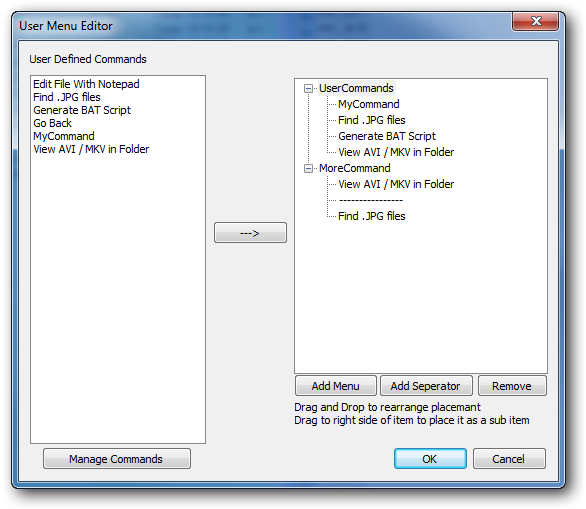User Menu Editor
Multi Commander's User Menu Editor provides powerful menu customization capabilities, allowing you to integrate your user-defined commands directly into the application's menu system. Create personalized menu structures that match your workflow and provide quick access to your most frequently used custom commands.
Menu Integration
The User Menu Editor bridges the gap between your custom commands and Multi Commander's interface, enabling seamless integration of personalized functionality into the standard menu bar.
Accessing the User Menu Editor
The User Menu Editor is available through Multi Commander's Configuration menu, providing centralized access to all menu customization features.
Opening the Menu Editor
- Open the Configuration menu
- Select Menu Customization
- The User Menu Editor dialog will open
Prerequisites
Before customizing menus, ensure you have created User Defined Commands that you want to add to your menus.
Related Tools
- User Defined Commands - Create custom commands
- Button Editor - Customize toolbar buttons
- Keyboard Customization - Assign hotkeys
Understanding the Interface
The User Menu Editor features a dual-panel interface that separates command management from menu structure organization.

The User Menu Editor showing user-defined commands on the left and customizable menu structure on the right
Left Panel: Available Commands
Command List
- User Defined Commands: All custom commands you've created
- Command Names: Displays the descriptive names of your commands
- Selection: Click to select commands for menu assignment
- Status: Shows which commands are already assigned to menus
Note: Only saved User Defined Commands appear in this list. Create commands first before using the Menu Editor.
Right Panel: Menu Structure
Tree List Organization
- Top Level: Main menu bar entries (File, Edit, View, etc.)
- Sub-Menus: Nested menu items and separators
- User Menus: Your custom menu categories
- Hierarchical View: Tree structure shows menu relationships
Tip: The tree structure mirrors exactly how menus will appear in Multi Commander's menu bar.
Creating and Managing Menu Items
The User Menu Editor provides intuitive tools for creating menu structures and adding commands to specific menu locations.
Adding Commands to Menus
Step-by-Step Process
- Select Command: Click on a User Defined Command in the left panel
- Choose Location: Select the target menu or submenu in the right panel tree
- Add Command: Click the "-->" button to add the command
- Verify Placement: Confirm the command appears in the correct menu location
Result: The command will appear in the selected menu with its defined name and description.
Creating New Menus
Menu Creation Options
- Top-Level Menu: Creates new menu bar entry
- Sub-Menu: Creates nested menu under existing entry
- Menu Separators: Visual dividers between menu sections
- Custom Naming: Define meaningful menu names
To Create: Click the "Add Menu" button and specify whether you want a top-level menu or a submenu under the currently selected item.
Menu Item Transfer Process
1. Select Source
- Browse available User Defined Commands
- Click to select the desired command
- View command details and description
2. Choose Destination
- Navigate the menu tree structure
- Select target menu or submenu
- Consider logical grouping and organization
3. Execute Transfer
- Click the "-->" transfer button
- Confirm placement in tree structure
- Test menu functionality in application
Organizing Menu Structure
Multi Commander provides flexible tools for arranging and reorganizing your custom menu structure to match your workflow preferences.
Drag and Drop Functionality
Rearranging Menu Items
- Drag Items: Click and drag menu items within the tree
- Reorder Entries: Change the sequence of menu items
- Move Between Menus: Transfer items to different menu categories
- Nested Organization: Create submenu hierarchies
Visual Feedback: The tree structure updates in real-time as you drag and drop items, showing exactly how menus will appear.
Menu Hierarchy Design
Organizational Strategies
- Functional Grouping: Group related commands together
- Frequency-Based: Place common commands in accessible locations
- Workflow-Oriented: Organize by task sequences
- User Categories: Create custom menu sections
Best Practice: Create logical menu hierarchies that match your daily workflow patterns for maximum efficiency.
Integration with Other Customization Tools
The User Menu Editor works seamlessly with Multi Commander's other customization features to create a comprehensive personalized interface.
User Defined Commands
Foundation: Create the commands that will populate your custom menus.
- Define command functionality
- Set descriptive names and tooltips
- Configure command parameters
- Test command execution
Button Editor
Alternative Access: Assign the same commands to toolbar buttons for quick access.
- Visual button interface
- Single-click command execution
- Custom button icons
- Multiple button modes
Keyboard Shortcuts
Rapid Access: Assign hotkeys to your most frequently used menu commands.
- Instant command execution
- No mouse required
- Customizable key combinations
- Context-sensitive shortcuts
Pro Tip
Start with a few essential commands in a simple menu structure, then gradually expand as you become comfortable with the interface. This approach prevents overwhelming yourself while building effective workflow automation.
Related Documentation
For comprehensive customization guidance, see User Defined Commands, Button Editor, and Keyboard Customization.